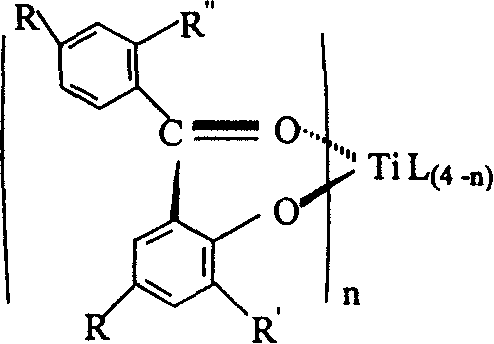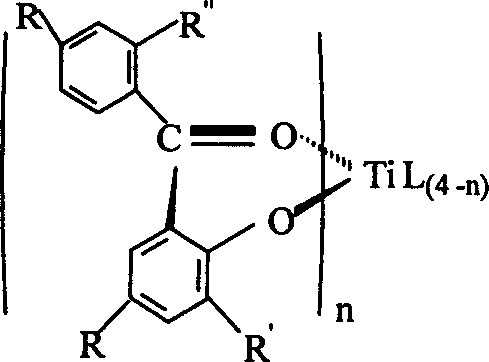2-hydroxy benzophenone titanium catalyst for synthesizing syndiotactic polystyrene and its preparing method
The technology of hydroxybenzophenone and polystyrene is applied in the field of non-locene catalyst and its preparation, which can solve the problems of low molecular weight of polymers, and achieve the effects of low production cost, optimized application performance and cheap raw materials
- Summary
- Abstract
- Description
- Claims
- Application Information
AI Technical Summary
Problems solved by technology
Method used
Image
Examples
Embodiment 1-10
[0024] Example 1-10: Synthesis of the structure, components and related properties of the catalyst of the present invention, see Table 1 for details.
[0025] Synthesize structure, component and related performance of catalyst of the present invention Table 1
[0026] Implementation R R R main catalyst Al / Ti T activity (×10 5 gPS Syndiotacticity T m m w (×
[0027] Example (°C) / molTi·h) % (°C) 10 4 )
[0028] 1 - CH 3 CH 3 A 2 Ti(OPh) 2 1100 20 0.5 96 265 16
[0029] 2CH 3 C 2 h 5 -ATiCl 3 500 80 8.3 93 270 23
[0030] 3C 3 h 7 -CH 3 A 3TiCl 2000 80 0.9 94 275 18
[0031] 4CH 3 C 3 h 7 C 2 h 5 ATi(OPh) 3 700 40 7.1 98 269 17
[0032] 5CH 3 O C 4 h 9 C 3 h 7 A 2 TiCl 2 600 90 4.8 95 267 29
[0033] 6C 4 h 9 O CH 3 CH 3 ATi(OEt) 3 800 60 6.4 94 266 30
[0034] 7-C 2 h 5 C 3 h 7 ATi(OPhOMe) 3 400 80 3.2 96 270 24 ...
Embodiment 1
[0040] N at room temperature 2 Among them, 0.42 g of ligand A of the structure shown in Table 1, that is, 2-hydroxybenzophenone 0.42 g, was dissolved in ether and added to the 4 Carry out complex coordination in the diethyl ether solution, then heat up to the solvent reflux temperature, reflux for 6 hours, filter and wash the precipitate, and vacuum dry to obtain the main catalyst A 2 Ti(OPh) 2 0.51g. In a 100ml two-necked flask replaced by nitrogen and equipped with a stirrer, add 15ml of toluene distilled by reflux of metal sodium, stir and raise the temperature to 20°C, add the main catalyst A 2 Ti(OPh) 2 .0.47mg (the concentration is 1.53×10 -5 mol / L), according to the molar ratio of cocatalyst and main catalyst, namely Al / Ti=1100 plus cocatalyst triisobutylaluminoxane 6.8ml, add 20ml of dried styrene. After 1 h of reaction, 10% acidified ethanol solution was added to terminate the reaction. The reactant was continuously stirred in excess ethanol for 2 h, filtered an...
Embodiment 2
[0042] N at room temperature 2 Dissolve 0.49 g of ligand A, that is, 2-hydroxybenzophenone with the structure shown in Table 1, in ether and add it to a solution containing 1.7 ml of TiCl 4 Carry out complexation and coordination in the diethyl ether solution, then raise the temperature to the solvent reflux temperature, reflux for 6 hours, filter and wash the precipitate, and vacuum dry to obtain the main catalyst ATiCl 3 0.36g. In a 100ml two-necked flask replaced by nitrogen and equipped with a stirrer, add 15ml of toluene distilled by reflux of metal sodium, heat up to 80°C under stirring, add the main catalyst ATiCl 3 20.6mg (concentration is 1×10 -3 mol / L), the cocatalyst is methylaluminoxane (MAO). According to the molar ratio of co-catalyst and main catalyst, ie Al / Ti=500, add 3.7 ml of co-catalyst and 20 ml of dried styrene. After 1 h of reaction, 10% acidified ethanol solution was added to terminate the reaction. The reactant was continuously stirred in excess ...
PUM
| Property | Measurement | Unit |
|---|---|---|
| melting point | aaaaa | aaaaa |
Abstract
Description
Claims
Application Information
 Login to view more
Login to view more - R&D Engineer
- R&D Manager
- IP Professional
- Industry Leading Data Capabilities
- Powerful AI technology
- Patent DNA Extraction
Browse by: Latest US Patents, China's latest patents, Technical Efficacy Thesaurus, Application Domain, Technology Topic.
© 2024 PatSnap. All rights reserved.Legal|Privacy policy|Modern Slavery Act Transparency Statement|Sitemap


